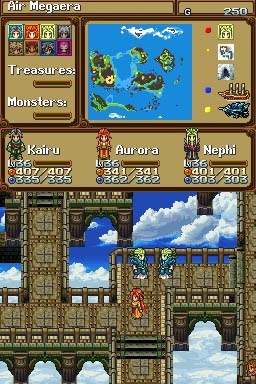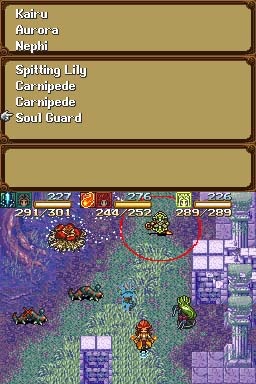With recent releases of such franchises as Final Fantasy and Dragon Quest on the Nintendo DS, the portable console has become a haven for traditional role-playing games. While it's certainly nice to revisit such landmark titles, there is also room for new tweaks to the classic formula. Studio Archcraft's Black Sigil: Blade of the Exiled is a retro-styled 2D RPG that feels like it could have been lifted directly from the Super Nintendo era. Although its traditional approach will please fans of the genre, Black Sigil's lack of innovation and frustrating battles will do little to attract new fans.

Black Sigil tells the story of Kairu, a cursed boy who was born without the ability to use magic. Fifteen years earlier, Kairu's father saved his land from the evil Vai, the only other man in Bel Lenora who could not use magic. Because of this similarity, people fear the boy and his disability, eventually forcing him into exile. Along with his sister, Aurora, Kairu finds himself in Artania, where a powerful regime is quickly taking over the land. In order to get home to Bel Lenora, the two must discover the true motives of the rulers and stop their advancement. It's an intriguing story with some interesting twists that, unfortunately, takes too long to get rolling. You are led around Artania by a multitude of characters, unaware of exactly what's going on or your companion's intentions until a few sequences later in the game when information is divulged en masse. In the meantime, however, the people you encounter along the way have personality and charm. Their dialogue is well written, jokes are actually funny, and none of the playable characters feel like stock additions.
Most of your time in Artania is spent exploring dungeons and stopping in towns to rest and gather information. There are eight playable characters throughout the game that join and leave your three-person party at various plot points. Dungeons are inventively designed so that your progression through the level depends on solving the puzzle of its layout. For example, when climbing a tower, you'll have to navigate one-way roads and elevators that change position depending on where you last rode the neighboring lift. Another level requires you to examine various bookshelves in a library to find alternate routes to the next floor. It's a fresh take on the traditional dungeon crawler that forces you to think about your path rather than just plowing through the level. It's a shame that you have to play the fairly linear main plotline for at least 10 hours or so before the overworld completely opens up and you're able to explore and search for side quests.
Battles are random and take place in the traditional turn-based format with an active time meter determining turn order. In lieu of a text-based menu system, you select physical attacks, spells, skills, and items by using the D pad. The stylus can also be used, but the face buttons are a more natural fit. For increased variety, you can team up with other party members to perform combined attacks that deal extra damage. You are also free to move around the field during battle, which adds an extra level of strategy when fighting in different environments.
Unfortunately, the encounter rate is sky high and will test your patience as you can sometimes take only two or three steps between battles. This tedium is exacerbated by battles that are often artificially lengthened by your characters' inability to reach enemies on the battlefield, forcing you to rely on magic attacks more often than you'd like. Depending on the enemies you encounter, your party begins many battles with random status effects, such as poison or blind. Furthermore, your weakest party member is often the most fiercely targeted. These tactics, combined with the enemies' ability to get in one last attack even after they have been defeated, make some fights feel unfairly balanced. Although there are a number of boss battles, epic fights with giant bosses are uncommon, and both are more often a battle of attrition than strategy.

Aesthetically, Black Sigil could sit alongside the great 2D RPGs of the Super Nintendo era. The design obviously does not take full advantage of the DS's hardware, but it still holds its own thanks to its attractive art style. Although the overworld map is plain and nondescript, individual environments are unique and colorful, giving character to each town, dungeon, or forest. The game's varied tunes also help distinguish the environments and give each area its own identity. Even the best RPG soundtracks can become grating over time, but you'll find Black Sigil's music a perfect fit for its retro style. In particular, the battle and town themes are so catchy that they'll stick with you after you've turned off your DS.
Black Sigil: Blade of the Exiled is an easy recommendation for old-school RPG fans who have put some time into any of the recent DS releases of such classic franchises as Final Fantasy, Dragon Quest, or Chrono Trigger. If you enjoy grinding away at random battles in the shoes of a reticent protagonist trying to save the world, you'll certainly have fun here. Unfortunately, it is this strict adherence to convention and lack of innovation that will turn casual fans away from Black Sigil.